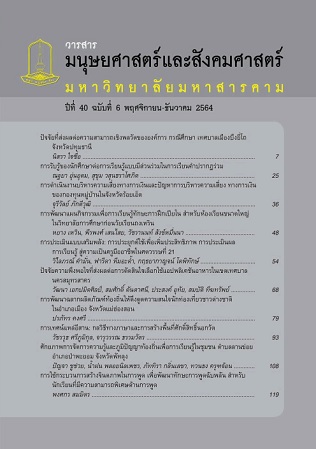การรับรู้ของนักศึกษาต่อการเรียนรู้แบบมีส่วนร่วมในการเรียนคำปรากฏร่วม
Main Article Content
บทคัดย่อ
งานวิจัยฉบับนี้มีวัตถุประสงค์เพื่อศึกษาการรับรู้การเรียนรู้แบบมีส่วนร่วมของนักศึกษาและเพื่อศึกษาการเรียนรู้คำปรากฏร่วมภายใต้การเรียนรู้แบบมีส่วนร่วม หลักการการเรียนรู้แบบมีส่วนร่วมได้รับการเสนอโดย Laufer และ Hulstijin (2001) ผู้อ้างถึงประสิทธิภาพของการเรียนรู้แบบมีส่วนร่วมต่อการเรียนรู้คำศัพท์และการจำคำศัพท์ ซึ่งประสิทธิภาพนี้มีผลมาจากองค์ประกอบของการเรียนรู้แบบมีส่วนร่วม นักศึกษาสาขาวิชาภาษาอังกฤษจำนวน 6 คนที่กำลังศึกษาอยู่ในมหาวิทยาลัยแห่งหนึ่งในประเทศไทยเข้าร่วมการสัมภาษณ์แบบกึ่งโครงสร้าง ก่อนที่นักศึกษาจะเข้าร่วมการสัมภาษณ์ นักศึกษาได้ทำแบบฝึกหัดคำปรากฏร่วมที่ออกแบบภายใต้การเรียนรู้แบบมีส่วนร่วม นักศึกษาต้องศึกษาคำปรากฏร่วมจากสื่อการเรียนรู้ซึ่งประกอบไปด้วยตัวอย่างประโยคและหน้าพจนานุกรมของคำปรากฏร่วม เพื่อใช้ในการทำแบบฝึกหัด ผลของงานวิจัยพบว่านักศึกษามีการรับรู้เชิงบวกต่อการเรียนคำปรากฏร่วมที่ออกแบบมาจากการเรียนรู้แบบมีส่วนร่วม ทั้งนี้ผลสะท้อนต่อการเรียนรู้แบบมีส่วนร่วมและการเรียนคำปรากฏร่วมจากสื่อการสอนของนักศึกษายังได้อภิปรายในบทความนี้
Article Details
เอกสารอ้างอิง
Benson, M., Benson, E. & Ilson, R. (1986). The BBI combinatory dictionary of English: A guide to word combinations. Amsterdam/Philadelphia: John Benjamins Publishing Company.
Chen, Y. (2016). Dictionary use for collocation production and retention: A call-based study. International Journal of Lexicography, 30(2), 225-251. Available at: https://doi.org/10.1093/ijl/ecw005
Craik, F. I. M. & R. S. Lockhart. (1972). Levels of processing: A framework for memory research. Journal of Verbal Learning and Verbal Behavior, 11, 671-684. Available at: https://doi.org/10.1016/S0022-5371(72)80001-X
Dankittikul, T. & Laohawiriyanon, C. (2018). Effect of Paper-based Concordance on Thai Low Proficiency English Language Learners’ Logical Connector Knowledge. Veridian E-Journal, 11(4), 61-78.
Erman, B. & Warren, B. (2000). The idiom principle and the open choice principle. TEXT, 20(1), 29-62. Available at: https://doi.org/10.1515/text.1.2000.20.1.29
Fallahrafie, Z., Rahmany, R. & Sadeghi, B. (2015). The effect of task-based teaching on incidental vocabulary learning in English for specific purposes. Cumhuriyet science journal, 36(3), 836-846.
Feng, T. (2015). Involvement load in translation tasks and EFL vocabulary learning. The New English Teacher, 9(1), 83–101.
Hill, J. (2000). Revising priorities: From grammatical failure to collocational success. In M.Lewis (ed.). Teaching collocation: Further development in the lexical approach. (pp. 47-69). Hove, England: Language Teaching Publications.
Hulstijn, J. H. & Laufer, B. (2001). Incidental vocabulary acquisition in a second language: The construct of task-induced involvement. Applied Linguistics, 22(1), 1–26. Available at: https://doi.org/10.1093 /applin/22.1.1.
Laufer, B. & Paribakht, T. (1998). The relationship between passive and active vocabularies: Effects of language learning context. Language Learning, 48, 365–391. Available at: https://doi.org/10.1111/0023-8333.00046.
Lewis, M. (2000). Teaching collocation: Further development in the lexical approach. London: Language Teaching Publications.
Mahvelati, E. H. (2019). Explicit and implicit collocation teaching methods: Empirical research and issues. Advances in Language and Literary Studies, 10(3), 105-116. Available at: https://doi.org/ 10.7575/aiac.alls.v.10n.3p.105
Phoocharoensil, S. (2011). Collocation errors in EFL learners’ interlanguage. Journal of education and practice, 2(3), 103-120.
Pourakbari, A. A. & Biria, R. (2015). Efficacy of task-induced involvement in incidental lexical development of Iranian senior EFL students. English Language Teaching, 8(5), 122–131. Available at: https://doi.org /10.5539/ELT.V8N5P122.
Shin, D. & Nation, P. (2008). Beyond single words: The most frequent collocations in spoken English. ELT journal, 62(4), 339-348. Available at: https://doi.org/10. 1093/ELT/ CCM091.
Shokouhi, H. & Mirsalari, G. (2010). Collocational knowledge versus general linguistic knowledge among Iranian EFL learners. TESL-EJ, 13(4), 9.
Snoder, P. (2017). Improving English learners’ productive collocation knowledge: The effects of involvement load, spacing, and intentionality. TESL Canada Journal, 34(3), 140-164. Available at: https://doi.org/10.18806/TESL.V34I3.1277
Suvarnamani, S. (2017). A study of grammatical and lexical errors in descriptive writing of first year Arts Students at Silpakorn University. Silpakorn university journal of social sciences, humanities, and arts, 17(2), 239-264.
Wasuntarasophit, S. (2015). Explicit instruction of collocations: An impact on learners’ use and perceptions. Journal of humanities and social sciences, 11(2), 37-71.
Woolard, G. (2000). Collocation-encouraging learner independence. In M. Lewis (ed.). Teaching collocation: Further development in the lexical approach. (pp. 28-46). London: Language Teaching Publications.
Yaemtui, W. & Phoocharoensil, S. (2019). Effectiveness of Data-driven Learning (DDL) on Enhancing High-proficiency and Low-proficiency Thai EFL Undergraduate Students’ Collocational Knowledge. The Asian EFL Journal, 23(3.2), 290-314.


